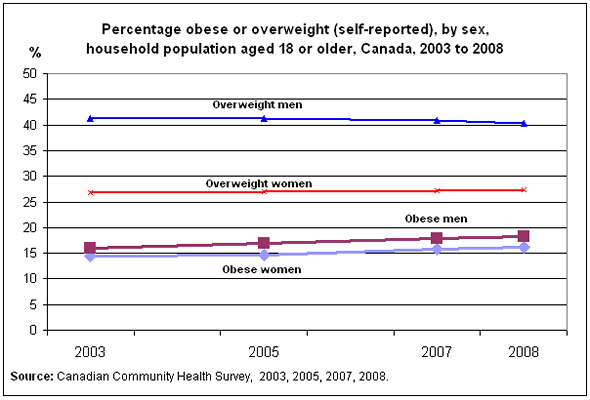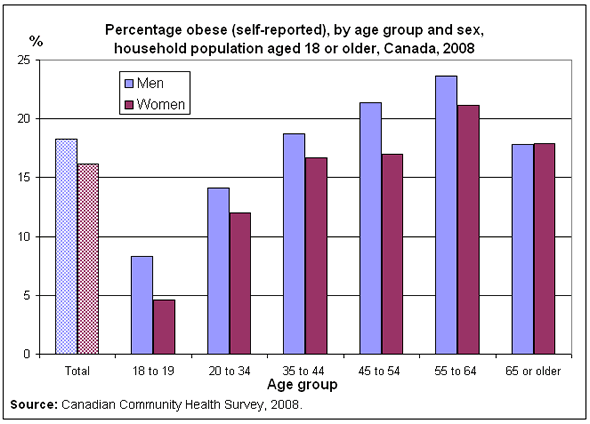Adults who are overweight or obese 2008
Archived Content
Information identified as archived is provided for reference, research or recordkeeping purposes. It is not subject to the Government of Canada Web Standards and has not been altered or updated since it was archived. Please "contact us" to request a format other than those available.

Obesity has been linked with many chronic diseases, including hypertension, Type 2 diabetes, coronary artery disease, osteoarthritis, and certain types of cancer.
To assess the health risks of obesity, the World Health Organization and Health Canada use guidelines based on Body Mass Index (BMI), a measure that examines weight in relation to height.
| Height | Overweight (increased risk of health problems) |
Obese (high to extremely high risk of health problems) |
|---|---|---|
| 5'4" (1.63 m) | 145.3 lbs (66.1 kg) or more | 174.4 lbs (79.3 kg) or more |
| 5'8" (1.73 m) | 164.1 lbs (74.6 kg) or more | 196.9 lbs ( 89.5 kg) or more |
| 6'0" (1.83 m) | 184.0 lbs (83.6 kg) or more | 220.7 lbs (100.3 kg) or more |
BMI can be used to compare body weight patterns and related health risks within and between populations and to establish population trends. At the individual level, this measure should be used with caution because the health risks associated with each BMI category vary considerably between individuals. Particular caution is warranted when classifying adults who are naturally very lean or very muscular, some ethnic and racial groups, and seniors.
The results shown here are based on weight and height as reported by survey respondents. Comparisons of self-reported weight and height with actual measurements have shown that women are inclined to underestimate their weight, while men tend to overestimate their height. Moreover, underreporting of weight increases proportionately with BMI (See Estimates of obesity based on self-report versus direct measures in Health Reports. The report found that the obesity rate was 7.4 percentage points higher and the overweight rate was 1.9 percentage points higher when based on measured height and weight rather than self-reported data).
In 2008, 17.2% of Canadians aged 18 or older, roughly 4.2 million adults, reported height and weight that classified them as obese. From 2003 to 2008, obesity among men rose from 16.0% to 18.3%, and among women, from14.5% to 16.2%.
When those who were overweight were included, 58.6% of Canadian men and 43.5% of women were at increased health risk because of excess weight.
The rates of those who were overweight have been stable from 2003 to 2008.
Chart 1

Residents of rural areas were more likely to be obese than were urban dwellers (20.9% versus 16.4%). The differences were even greater when the overweight population was included. In 2008, 58.3% of rural residents were overweight or obese, compared with 49.5% of urban Canadians.
Only in British Columbia (13.5%) and Quebec (15.5%) were obesity rates significantly lower than the national average. Rates in Ontario, Alberta and Yukon were about the same as the Canadian rate, and in all other provinces and territories rates were significantly above the national average.
The highest rate of obesity (22.4%) was at ages 55 to 64, and the lowest (6.6%) at ages 18 to 19.
Chart 2

In successively older age groups from 18 to 64, the percentage of Canadians of normal weight declined significantly, and the percentage in the combined overweight/obese category increased significantly.
Seniors (65 or older) had a combined overweight/obese rate that was lower than that of the next younger group and about the same as the 45 to 54 age group.
Chart 3

Source
Additional information from the Canadian Community Health Survey is available from CANSIM table: 105-0501.
References
Adult obesity. Tjepkema M. 2006; 17(3): 9-25.
Body mass and dependency. Wilkins K, de Groh M. 2005; 17(1): 27-39.
Effects of measurement on obesity and morbidity. Shields M, Connor Gorber S, Tremblay MS. 2008; 19(2): 77-84.
Estimates of obesity based on self-report versus direct measures. Shields M, Connor Gorber S, Tremblay MS. 2008; 19(2): 61-76.
The feasibility of establishing correction factors to adjust self-reported estimates of obesity. Connor Gorber S, Shields M, Tremblay MS, McDowell I. 2008; 19(3): 71-82.
Obesity—a growing issue. Le Petit C, Berthelot J-M. 2006; 17(3): 43-50.
Obesity and the eating habits of the Aboriginal population. Garriguet D. 2008; 19(1): 21-35.
Obesity, overweight and ethnicity. Tremblay MS, Pérez CE, Ardern CI, et al. 2005; 16(4): 23-34.
Overweight and obesity among children and youth. Shields M. 2006; 17(3): 27-42.
Regional differences in obesity. Shields M, Tjepkema M. 2006; 17(3): 61-7.
Screen time among Canadian adults: A profile. Shields M, Tremblay MS. 2008; 19(2): 31-43.
Sedentary behaviour and obesity among Canadian adults. Shields M, Tremblay MS. 2008; 19(2): 19-30.
Trends in adult obesity. Shields M, Tjepkema M. 2006; 17(3): 53-9.
Trends in weight change among Canadian adults. Orpana HM, Tremblay MS, Finès P. 2007; 18(2): 9-16.
- Date modified:
